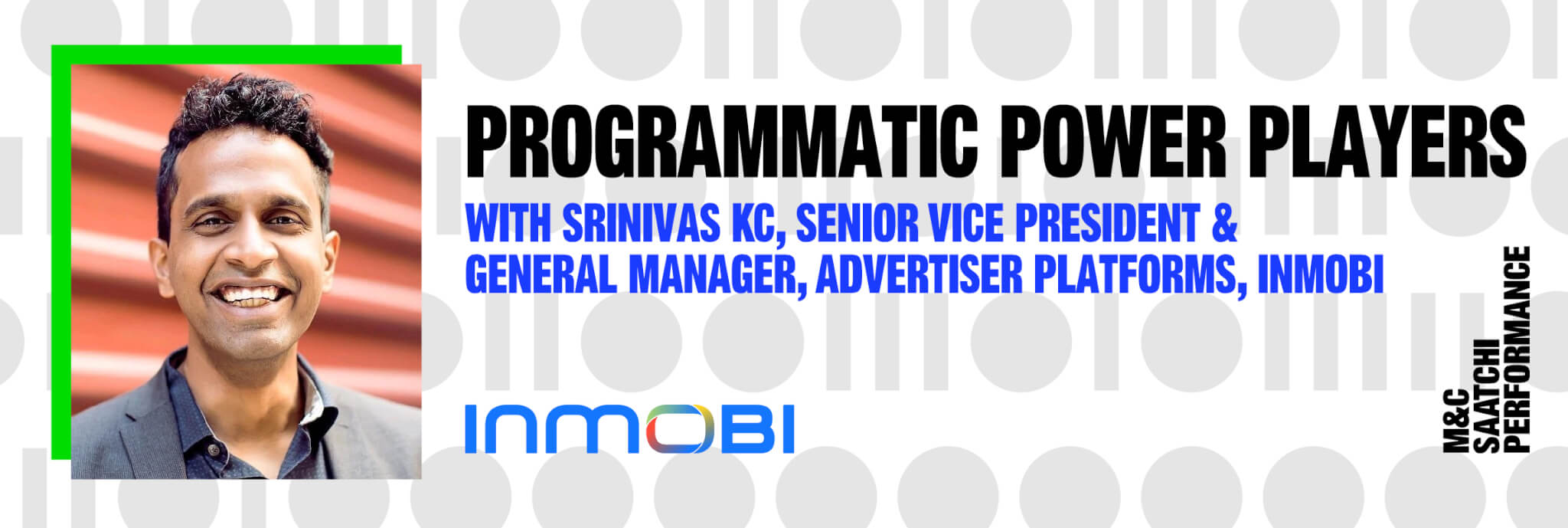

Srinivas KC is the Senior Vice President and General Manager of Advertiser Platforms at InMobi. As a leading mobile marketing technology platform, InMobi aims to drive real connections between advertisers and consumers. We sat down with KC to discuss the modern performance marketing landscape, the pros and cons of self-serve and managed DSP solutions and the future of mobile ad tech.
Srinivas KC has also recently contributed to a new report, Advertising in the Privacy Era: A Guide for Mobile Marketers. You can download your copy here.
Key takeaways:
- Contextual signals are key to mobile campaign attribution and optimization in a privacy-first world. Information such as device type, app usage, and even time of day can help ad tech platforms understand what unique conditions drive quality user acquisitions most efficiently.
- Most performance advertisers are working off an acquisition-cost-to-LTV risk vs. reward model, which should inform their strategy about whether to use a self-serve solution or managed service DSP. Self-serve offers control and transparency, while managed DSPs offer transparency and performance guarantees.
- The potential for fraud exists on both the supply and demand sides in the mobile advertising world. Marketers partnering with performance ad platforms should ensure that their partners can distinguish between ad fraud and legitimate activity on both sides to maximize investment.
What signals does InMobi use to target iOS audiences post-ATT?
We use privacy-safe contextual signals, which go much deeper than just the types of content a user interacts with. We consider when, where, and how mobile users engage at a macro level, and the types of apps where ads are served. These signals allow us to learn more about what conditions inspire high-value users to take action without knowing who they are.
For example, we may explore location signals of varying granularity, ranging from precise latitude and longitude to broader areas like city or region. Next, we can look at the device model, OS version, network connection type, and temporal information such as time of day. These types of signals tell a lot about whether and how much to bid on a given impression without violating their privacy and can be evaluated dynamically and continuously alongside creative attributes to optimize ad performance.
At InMobi, we took this a step further and built an automated privacy-safe bidder that’s free from individual-level identifiers and fully compliant with Apple’s privacy-preserving frameworks. The modern form of contextual targeting I’ve described is a top priority for us, and we believe this strategy will prove resilient as the ad tech ecosystem continues to evolve.
How do ad tech platforms manage performance measurement for iOS campaigns within SKAN?
Despite the challenges it poses, Apple’s SKAdNetwork is a neutral and objective attribution platform. In legacy measurement systems, large walled-garden operators were self-attributing, effectively grading their own homework. However, SKAdNetwork changed everything — it grades everyone as equals and objectively measures attribution while offering greater transparency.
As our industry collectively adapts to a privacy-first world, it’s essential for buy-side adtech to provide advertisers visibility into media costs and performance. We can achieve this through a mix of predictive modeling, self-serve reporting, and API integration capabilities. For example, our privacy-safe bidder for iOS is purpose-built to align with Apple’s SKAdNetwork attribution framework. We also partner closely with Mobile Measurement Platforms (MMPs) to advise advertisers on how to configure conversion models for SKAN to maximize insight into campaign performance and optimization. We’ve also developed predictive algorithms that calculate a modeled conversion value with high confidence to account for SKAN postbacks received before enough daily installs occur to surpass the privacy threshold. Algorithms like this give advertisers a truer picture of performance and costs while enhancing campaign optimization efforts.
How can performance marketers make the best use of first-party data?
Performance marketing is a game of machine learning, and data is the fuel. With the loss of user-level identifiers, first-party data is more valuable than ever. We put this data to work by seeding machine learning models with first-party audience insights on the ideal customer profile. Advertisers can then deploy lookalike targeting to rapidly scale a data set and uncover which audience members have the greatest probability of becoming high-value users.
What is the advantage of working with a managed service DSP? When should performance advertisers favor self-serve or even homegrown bidding solutions?
First of all, homegrown solutions developed and maintained by advertisers in-house often just don’t work. Homegrown bidders only have their own data to rely on, which typically isn’t enough to be successful. One may choose to go self-serve with programmatic for two key reasons: transparency and control. Price and supply transparency help you track return on ad spend (ROAS) because you’ll always know what you paid, what you bought, and where it ran. Control gives well-resourced marketers full “hands on keyboard” ability to adjust campaigns as they see fit with limited-to-no third-party intervention.
When it comes to the managed or self-serve debate, a lot of it comes down to risk versus reward. Most performance advertisers are working off of a customer acquisition cost (CAC) to lifetime value (LTV) risk/reward model. Imagine you’re a ride-sharing company, and you want to spend a fixed cost per new rider, so you offer a promotional discount off the first ride for new customers. Evaluating the lifetime value of new customers who take advantage of this discount program enables this ride-sharing company to calculate an acquisition-to-LTV algorithm. The idea is for them to reliably predict how much revenue each new rider who redeems the discount offer will generate over time. Now, in a self-serve model, if this advertiser acquires new users who spend far less than their algorithm predicts, they are fully on the hook to absorb this lower level of ROI. In a managed service model, the advertiser could pass that risk on to a partner who guarantees to deliver the quality of riders they seek at a specified cost, or they don’t pay.
The evergreen trifecta in advertising is transparency, control, and performance. With self-serve, you get transparency and control, but you can’t guarantee performance. With managed DSPs, you get transparency and performance guarantees, but not control, since someone else’s hands are at the keyboard.
Fraud continues to present challenges in the programmatic space. Can you speak to these issues and share how to combat them?
Fraud exists in multiple forms in this space, and there has been a lot of sophisticated effort to counter it. One example of fraud is when publishers show an abnormally high volume of ads to users in a short period of time, such as 10-20 ads per minute, which renders impressions meaningless. We combat this by ensuring that 100% of the ads shown are viewable for at least a few seconds. Performance advertisers typically don’t mandate the need for viewability, but many brand advertisers will. Brand advertisers often pay based on CPM, so they measure success in terms of human viewability.
Another common type of fraud is click bots simulating human interactions, leading to artificially inflated click-through rates (CTR). A key method for detecting this form of fraud centers around click-to-install time. Humans tend to click on an ad, install an app, and open it within a few days. This entire chain of events typically occurs within 2-24 hours. If the app is installed and opened much later than this known time distribution, then it’s worth investigating the validity of clicks. We track all of this at runtime to ensure that any suspicious activity is captured and blocked.
These are just a few examples, and fraud is always evolving. It’s important that marketers understand how their partners identify and distinguish between ad fraud and legitimate activity on both sides to ensure they are maximizing investment and not misreporting. It’s also worth noting that with SKAdNetwork, Apple takes on the burden of fraud monitoring, providing a cryptographic signature with each postback for the purposes of verifying the authenticity of a conversion event.
What’s your prediction for the world of mobile ad tech in the next five years?
First of all, we will definitely continue to see a larger movement towards privacy, and modernized forms of contextual advertising will become more important as a result. This shift will naturally be reflected in the ad tech stack as well. Most of the ad tech stacks today work off the exchange of user segments, but we’ll see a move into data clean rooms to protect user-level and company-level data. Stronger walls will be built around data flows.
Second, on-device auctions will become a much more common approach to mediating ad supply because user data is only sensitive if it leaves the device. If it stays on the device, users might be willing to share certain data to see more relevant ads. It will take some time for on-device auctions to become the norm, but they will steadily become more common over the next five years.
And finally, every company in adtech will increasingly become a mix of software and owned/operated ad inventory. Not everyone will be able to make this transition, but they will try. In a privacy-first world, the only way to identify users without compromising privacy is if they log into your app and agree to give you data. To leverage that privilege, you’ll need to establish direct relationships with consumers through apps you own and operate.
Thanks for chatting with us, KC!
About Srinivas KC
Srinivas KC joined InMobi in 2011 and held a handful of roles there before becoming Senior Vice President and General Manager, Advertiser Platforms. With a degree in mechanical engineering and an MBA in Business Administration and Management from the Indian Institute of Management Ahmedabad, KC puts his expertise to work building InMobi’s DSP. His career has taken him to Hong Kong, Kuala Lumpur, and India, while he currently works out of San Francisco.
Interested in becoming a Performance Power Player, contact us if you would like to be considered as a contributor to our blog.
Don’t forget to download a copy of Advertising in the Privacy Era: A Guide for Mobile Marketers for more insights from Srinivas KC.

